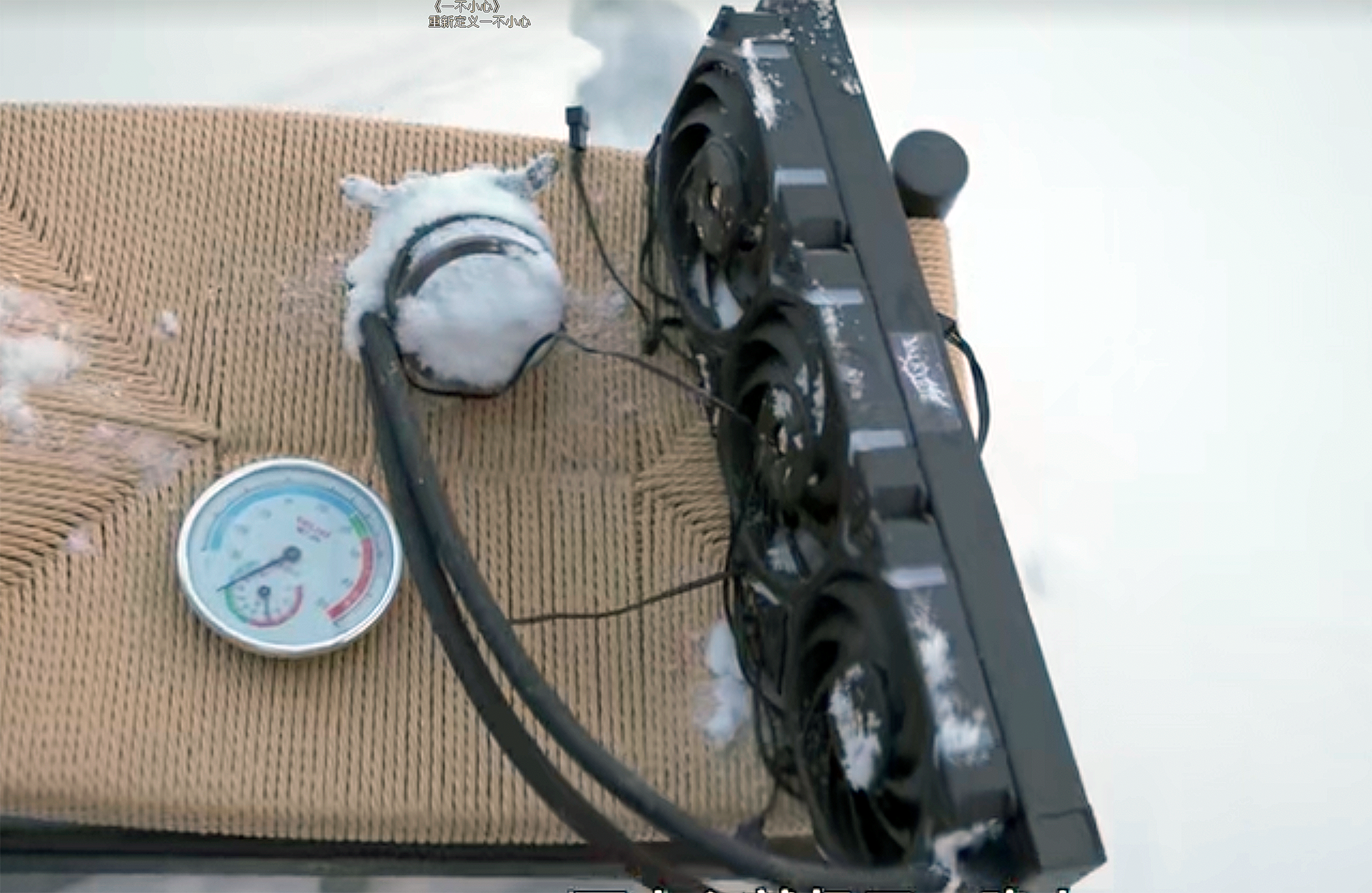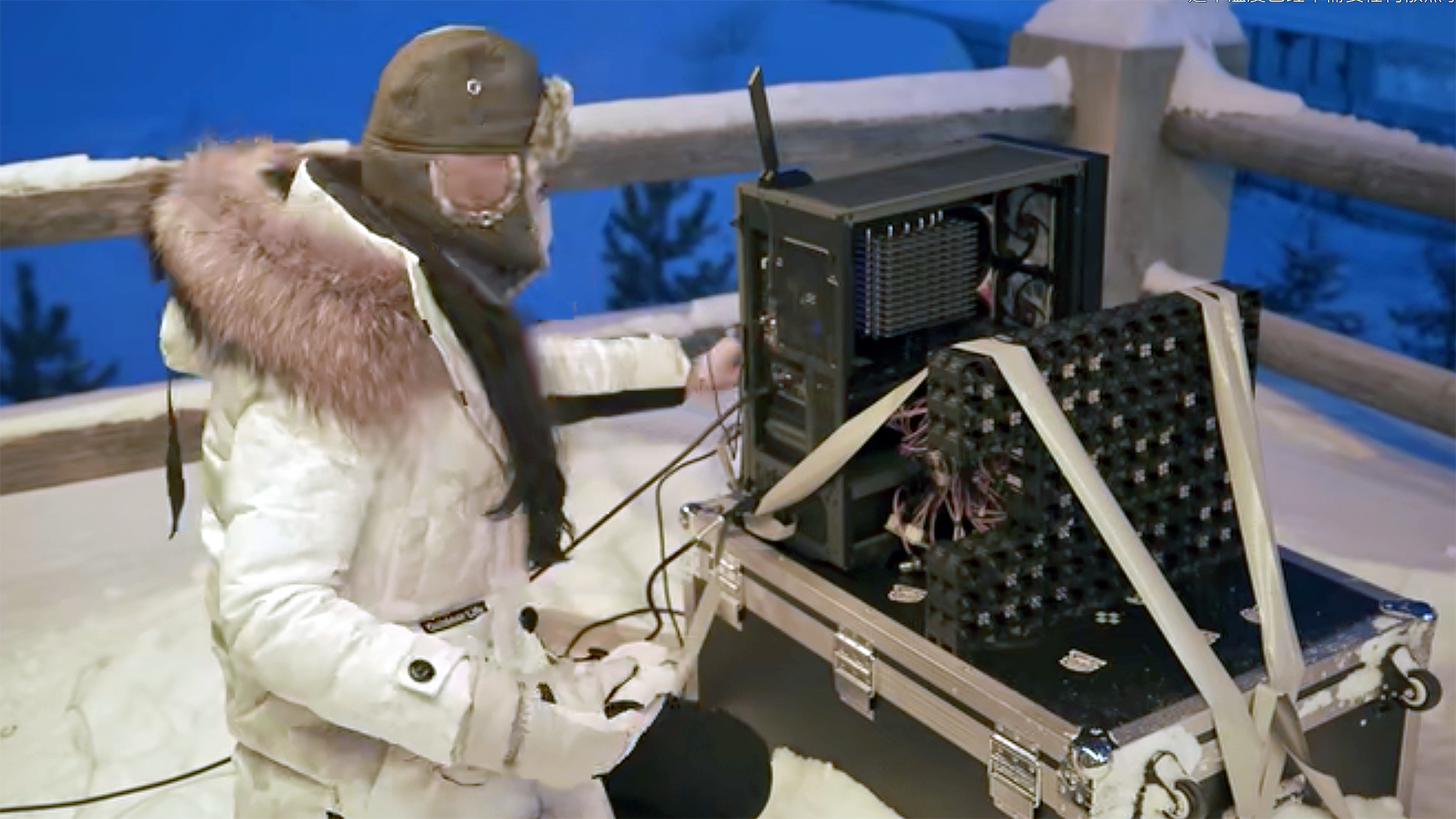Core i9-13900K and RTX 4090 Run at Sub-Zero Temps Outside
High-end gaming desktop used with air cooling at -53 C.
Baka, a Chinese PC hardware enthusiast and content creator, has attempted to use a modern gaming PC equipped with Intel's Core i9-13900K processor and Asus's GeForce RTX 4090 ROG Strix graphics card at subzero temperatures outside in the city of Mohe for a night, reports WCCFTech. To a great surprise, the hardware not only worked fine for some time, but actually survived the experiment.
Modern high-end processors and graphics cards for desktops dissipate so much heat that usage of advanced liquid coolers is recommended for CPUs, whereas graphics boards come with rather monstrous three-wide triple-fan air cooling systems. But such sophisticated coolers apparently aren't necessary if the temperature falls between -30 degrees Celsius to -53 C (-22 degrees Fahrenheit to -63.4 F) outside and you can ensure that that the hardware does not short circuit.

At first, Baka just installed her PC outside and removed its side panel, as it did not let her film the insides at such temperatures. But at -30 C and -40 C, liquid in the closed-loop 360-mm liquid CPU cooler froze and the device simply stopped working. To cool down the processor, she had to install Noctua's NH-P1 passive heatsink and build a monstrous air compressor out of dozens of high-pressure server fans that created sound that was as horrific as the compressor looked.

But it worked out just fine. The CPU temperature dropped to 10°C to 15°C and the 24-core Raptor Lake processor — the best gaming CPU you can get these days — had enough thermal headroom to hit 6.18 GHz. Temperature of Nvidia's GeForce RTX 4090 — the best graphics card available today — dropped to -40°C at idle and never went past 30°C under high loads. The machine survived at subzero temperatures for a couple of nights, although it is unclear how significantly hardware degraded when working in such mode. We would be particularly concerned about DRAM and 3D NAND memory chips as well as things like MACs, DACs, and capacitors.

Baka used the system for some to play some Minesweeper, but did not attempt to overclock the CPU and the GPU. This is probably because it was pointless to compete against extreme overclockers who use liquid nitrogen(-90°C).
In any case, while it is hardly possible to use high-end PCs in a freezer for prolonged periods, the experiment looks like a lot of fun.
Get Tom's Hardware's best news and in-depth reviews, straight to your inbox.

Anton Shilov is a contributing writer at Tom’s Hardware. Over the past couple of decades, he has covered everything from CPUs and GPUs to supercomputers and from modern process technologies and latest fab tools to high-tech industry trends.
-
cyrusfox Need to change that fluid up, anti-freeze(50/50) is good to -38°C, maybe good enough for this current application.Reply -
Reply
She already knows.cyrusfox said:Need to change that fluid up, anti-freeze(50/50) is good to -38°C, maybe good enough for this current application.
From the article:
But at -30 C and -40 C, liquid in the closed-loop 360-mm liquid CPU cooler froze and the device simply stopped working. To cool down the processor, she had to install Noctua's NH-P1 passive heatsink and build a monstrous air compressor out of dozens of high-pressure server fans that created sound that was as horrific as the compressor looked.
-
cyrusfox Reply
Yes I know she knows and went with a passive heatsink and jerry rigged a compressor, that's a lot of extra power and space.Nolonar said:She already knows.
My comment was don't do a closed loop, open it up and use anti-free, May burn up some pumps though but that is the beauty of open loop, easy to replace. -
frogr Reply
"Due to possible slush creation, ethylene glycol and water solutions should not be used in conditions close to freezing points. "cyrusfox said:Need to change that fluid up, anti-freeze(50/50) is good to -38°C, maybe good enough for this current application.
-> https://www.engineeringtoolbox.com/ethylene-glycol-d_146.htmlAlso years ago, the factory antifreeze mix in my new Saab slushed up and my car overheated on the freeway at -30C -
PEnns "But such sophisticated coolers apparently aren't necessary if the temperature falls between -30 degrees Celsius to -53 C (-22 degrees Fahrenheit to -63.4 F) outside...."Reply
Those lucky Mongolian gamers, playing outside in balmy sub zero temps!! What's next, Intel lava-like processors are great for playing at absolute zero temps on Neptune?? -
bit_user Why is it so surprising that it worked? If you don't let the PC get too cold before turning it on, then I'd expect it to.Reply
To cool down the processor, she had to install Noctua's NH-P1 passive heatsink and build a monstrous air compressor out of dozens of high-pressure server fans that created sound that was as horrific as the compressor looked.
Um, why couldn't she just use a normal Noctua tower cooler with its own fan? Maybe she tried the passive cooler to see how well it would work on its own, and didn't have ready access to, or funds to buy an active tower cooler?
Could there be some issue with fans' bearings freezing that maybe doesn't apply to the server fans? -
Howardohyea Reply
My thoughts exactly, if there isn't any liquid components (like AIO) in the PC, it should function more or less just fine regardless of temperature.bit_user said:Um, why couldn't she just use a normal Noctua tower cooler with its own fan? Maybe she tried the passive cooler to see how well it would work on its own, and didn't have ready access to, or funds to buy an active tower cooler?
Could there be some issue with fans' bearings freezing that maybe doesn't apply to the server fans?
That reminded me, the liquid in the vapor chamber may freeze, but when it thaws I think it's going to be alright. -
bit_user Reply
BTW, my comment about fan bearings was in relation to some of them being "fluid dynamic bearings", which I'm guessing use oil as the fluid. Oil gets viscous, at low temperatures, which could prevent the fans from spinning. Even the amount of oil in ball bearing fans could be an issue. Maybe that's why she had to use high-torque server fans? Otherwise, it seems like a fairly random thing to do.Howardohyea said:My thoughts exactly, if there isn't any liquid components (like AIO) in the PC, it should function more or less just fine regardless of temperature.
There probably is some temperature that's so cold the "far" side of the vapor chamber might not be able to stay unfrozen, leading to all the fluid collecting as icicles there, instead of flowing back along the walls. The walls themselves don't conduct heat very well, limiting the ability of them to thaw the frozen part.Howardohyea said:the liquid in the vapor chamber may freeze, but when it thaws I think it's going to be alright.